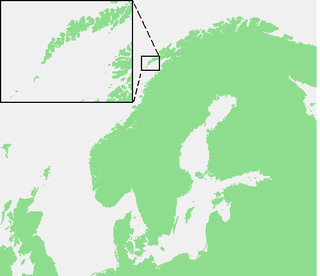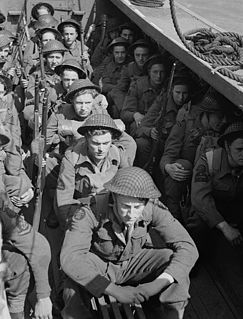
The Commandos also known as British Commandos were formed during the Second World War in June 1940, following a request from the Prime Minister of the United Kingdom, Winston Churchill, for a force that could carry out raids against German-occupied Europe. Initially drawn from within the British Army from soldiers who volunteered for the Special Service Brigade, the Commandos' ranks would eventually be filled by members of all branches of the British Armed Forces and a number of foreign volunteers from German-occupied countries. By the end of the war 25,000 men had passed through the Commando course at Achnacarry. This total includes not only the British volunteers, but volunteers from Greece, France, Belgium, Netherlands, Norway, Poland, and the United States Army Rangers, which were modelled on the Commandos.

No. 62 Commando or the Small Scale Raiding Force (SSRF) was a British Commando unit of the British Army during the Second World War. The unit was formed around a small group of commandos under the command of the Special Operations Executive (SOE). They carried out a number of raids before being disbanded in 1943.

Operation Claymore was the code name for a British commando raid on the Lofoten Islands in Norway during the Second World War. The Lofoten Islands were an important centre for the production of fish oil and glycerine, used in the German war economy. The landings were carried out on 4 March 1941, by the men of No. 3 Commando, No. 4 Commando, a Royal Engineers Section and 52 men from the Norwegian Independent Company 1. Supported by the 6th Destroyer Flotilla and two troop transports of the Royal Navy, the force made an unopposed landing and generally continued to meet no opposition. The original plan was to avoid contact with German forces and inflict the maximum of damage to German-controlled industry. They achieved their objective of destroying fish oil factories and some 3,600 t of oil and glycerine. The British experienced only one accident; an officer injuring himself with his own revolver and returned with some 228 German prisoners, 314 loyal Norwegian volunteers and a number of Quisling regime collaborators.

Operation Anklet was the codename given to a British Commando raid during the Second World War. The raid on the Lofoten Islands was carried out in December 1941, by 300 men from No. 12 Commando and the Norwegian Independent Company 1. The landing party was supported by 22 ships from three navies.

3 Commando Brigade is a commando formation of the British Armed Forces and the main manoeuvre formation of the Royal Marines. Its personnel are predominantly Royal Marines, supported by units of Royal Engineers, Royal Artillery, and the Fleet Air Arm, together with other Commando Qualified sailors, soldiers and airmen.
No. 7 Commando was a unit of the British Commandos and part of the British Army during the Second World War. The commando was formed in August 1940 in the United Kingdom. No. 7 Commando was transferred to the Middle East as part of Layforce. Committed to the Battle of Crete, it suffered heavy casualties, after which it was disbanded.
No. 11 (Scottish) Commando was a battalion-sized commando unit of the British Army during the Second World War. Formed in Scotland, members of No. 11 (Scottish) Commando adopted the Tam o'shanter as their official headdress.

No. 9 Commando was a battalion-sized British Commando unit raised by the British Army during the Second World War. It took part in raids across the English Channel and in the Mediterranean, ending the war in Italy as part of the 2nd Special Service Brigade. Like all Army commando units it was disbanded in 1946.
No. 44 Commando was a battalion size formation in the British Commandos, formed during the Second World War. The Commando was assigned to the 3rd Special Service Brigade and served in the Burma Campaign.
No. 50 Commando was a battalion-sized British Commando unit of the British Army during the Second World War. The commando was formed in 1940, from volunteers in Egypt and Palestine. Shortly after formation it was amalgamated with No. 52 Commando and became 'D' Battalion, Layforce.
No. 52 Commando was a battalion-sized British Commando unit of the British Army during the Second World War. The commando was formed in 1940, from volunteers in Egypt and Palestine. Shortly after formation it was amalgamated with No. 50 Commando and became 'D' Battalion, Layforce.
No. 51 Commando was a battalion-sized British Commando unit of the British Army during the Second World War. The commando was formed in 1940, from Jewish and Arab volunteers from Palestine. The Commando fought against the Italians in Abyssinia and Eritrea before it was absorbed into the Middle East Commando.
Timberforce was the name given to units of No. 12 Commando and No. 14 (Arctic) Commando formed at various times between 1943 and 1944 for raids and reconnaissance of the Norwegian coastline.
No. 46 Commando was a battalion size formation of the Royal Marines, part of the British Commandos, formed in August 1943 during the Second World War. The Commando was assigned to the 4th Special Service Brigade and served in North-west Europe and took part in the D-Day landings, as well as operations around Ostend and Antwerp, before being disbanded after the war in January 1946.
Operation Kitbag was a raid in Norway by British Commandos of No 6 Commando and No. 12 Commando in December 1941, during the Second World War.

Operation Myrmidon was the planned raid during the Second World War by No. 1 Commando and No. 6 Commando in April 1942. This operation was an abortive raid on the Adour Estuary in south-western France. The plan was to disrupt road and rail transport between France and Spain by landing approximately 3,000 troops, consisting of two commandos, No. 1 and No. 6, who would be followed up by one and a half Royal Marine battalions along with an armoured regiment and a motor battalion. After embarking on the transport ships Queen Emma and Princess Beatrix, the force spent a month sailing off the French coast disguised as Spanish merchant ships. On 5 April the ships approached the mouth of the estuary in order to carry out the landing. However, amid bad weather, they encountered a sandbar that they had not expected and were unable to pass it; the raid was called off and the ships returned to the United Kingdom.

The Raid onBardia was an amphibious landing at the coastal town of Bardia in North Africa by British Commandos over the night of 19/20 April 1941 during the Second World War. The raid was carried out by No. 7 Commando also known as A Battalion Layforce together with a small detachment from the Royal Tank Regiment supported by five navy ships and a submarine. The raid—which destroyed an Italian artillery battery and a supply dump—was deemed a success despite the loss of 71 men. The more lasting strategic effect of the raid was the diversion of a German armoured brigade from the front line to provide rear area security.
The Twin Pimples Raid was a British Commando raid on a feature in the Italian lines during the siege of Tobruk in the Second World War. The raid, carried out by men of the No. 8 (Guards) Commando and the Royal Australian Engineers, was a complete success. However it did not end the siege; that continued until November 1941, when the Allied advance during Operation Crusader reached the town.







